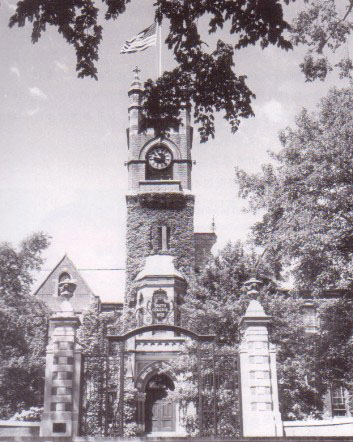● Going
to School in America Today
● Education—A Local Matter
● What
an American Student Learns
● Education
in a New Nation
● Learning
to Be World Citizens
● Higher Education
● Selecting
a College or University
● Trends in Degree Programs
● Education for All
Education for All
 In
1944 Congress passed the Servicemen's Readjustment Act, soon popularly
called the "GI
Bill of Rights." ("GI" at the time, was a
nickname for the American soldier. The nickname came from an abbreviation
for "Government Issue"—the uniforms and other articles
"issued" to a soldier.) The Act promised financial aid,
including aid for higher education, to members of the armed forces
after the end of World War II. In
1944 Congress passed the Servicemen's Readjustment Act, soon popularly
called the "GI
Bill of Rights." ("GI" at the time, was a
nickname for the American soldier. The nickname came from an abbreviation
for "Government Issue"—the uniforms and other articles
"issued" to a soldier.) The Act promised financial aid,
including aid for higher education, to members of the armed forces
after the end of World War II.
 The
war ended in the following year. The prediction had been that 600
000 war veterans would apply for aid for education. By 1955, more
than two million veterans of World War II and of the Korean War
had used the GI Bill of Rights to go to college. Many of these veterans
were from poor families. 30% were married when they applied for
college aid; 10% had children. More than a few had to work part
time while they took courses. It was difficult, but these veterans
believed that a college degree (which they could not afford on their
own) would improve their chances for a good job in the postwar economy.
Some went to liberal arts colleges; others to technical and professional
institutions. Their outstanding success in all these schools forced
everyone connected with higher education to rethink its purpose
and goals. Within just a few years, American veterans
had changed the image of who should go to college. In postwar America,
other groups sought their place on America's campuses, too. The
enrollment of women in higher education began to increase. Racial
segregation in elementary and secondary education ended, and thus
blacks achieved an equal opportunity to get into any college of
their choice. The
war ended in the following year. The prediction had been that 600
000 war veterans would apply for aid for education. By 1955, more
than two million veterans of World War II and of the Korean War
had used the GI Bill of Rights to go to college. Many of these veterans
were from poor families. 30% were married when they applied for
college aid; 10% had children. More than a few had to work part
time while they took courses. It was difficult, but these veterans
believed that a college degree (which they could not afford on their
own) would improve their chances for a good job in the postwar economy.
Some went to liberal arts colleges; others to technical and professional
institutions. Their outstanding success in all these schools forced
everyone connected with higher education to rethink its purpose
and goals. Within just a few years, American veterans
had changed the image of who should go to college. In postwar America,
other groups sought their place on America's campuses, too. The
enrollment of women in higher education began to increase. Racial
segregation in elementary and secondary education ended, and thus
blacks achieved an equal opportunity to get into any college of
their choice.
 By
the end of 1960s, some colleges introduced special plans and programs
to equalize educational opportunities—at every level, for all groups.
Some of these plans were called "Affirmative
Action Programs." Their goal was to make up for past
inequality by giving special reference to members of minorities
seeking jobs or admission to college. (In the United States, the
term "minority" has two meanings, often related: (a) A
minority is any ethnic or racial group that makes up a small percentage
of the total population; (b) The term also suggests a group that
is not the dominant political power.) Some colleges, for example,
sponsored programs to help minority students prepare for college
while still in high school. By
the end of 1960s, some colleges introduced special plans and programs
to equalize educational opportunities—at every level, for all groups.
Some of these plans were called "Affirmative
Action Programs." Their goal was to make up for past
inequality by giving special reference to members of minorities
seeking jobs or admission to college. (In the United States, the
term "minority" has two meanings, often related: (a) A
minority is any ethnic or racial group that makes up a small percentage
of the total population; (b) The term also suggests a group that
is not the dominant political power.) Some colleges, for example,
sponsored programs to help minority students prepare for college
while still in high school.
 By
the 1970s, the United States government stood firmly behind such
goals. It required colleges and universities receiving public funds
to practice some form of affirmative action. But when colleges began
to set quotas (fixed numbers) of minority students to be
admitted, many Americans (including minority citizens) protested.
They felt that this was another form of discrimination. By
the 1970s, the United States government stood firmly behind such
goals. It required colleges and universities receiving public funds
to practice some form of affirmative action. But when colleges began
to set quotas (fixed numbers) of minority students to be
admitted, many Americans (including minority citizens) protested.
They felt that this was another form of discrimination.
 |
|
Minority Students
|
 As
with most (but not all) problems in American public life, the conflict
was resolved by change and compromise. Colleges continued to serve
the goal of affirmative action—but in less controversial
ways. One large university, for example, announced a new policy:
It would seek to admit students who would add diverse talents to
the student body. It thus dealt with all applicants—minorities
included—on a basis that was not restricted to high school performance
and entrance tests, but which took into account the talents, voluntary
activities and "life experience" of the student. What
success did these efforts have? American college students are an
increasingly diverse group. In 1987, 54% were women. Women received
51% of the bachelor's and master's degrees awarded that year, and
35% of the doctorates and professional degrees. But not all groups
are doing so well. As
with most (but not all) problems in American public life, the conflict
was resolved by change and compromise. Colleges continued to serve
the goal of affirmative action—but in less controversial
ways. One large university, for example, announced a new policy:
It would seek to admit students who would add diverse talents to
the student body. It thus dealt with all applicants—minorities
included—on a basis that was not restricted to high school performance
and entrance tests, but which took into account the talents, voluntary
activities and "life experience" of the student. What
success did these efforts have? American college students are an
increasingly diverse group. In 1987, 54% were women. Women received
51% of the bachelor's and master's degrees awarded that year, and
35% of the doctorates and professional degrees. But not all groups
are doing so well.
 |
|
Smith College—A
Private Women's College
|
 Although
59% of the students who graduated from high school in 1988 enrolled
in college that same year, only 45% of the African-American high
school graduates went on to college. Educators and others are working
to increase that percentage. Although
59% of the students who graduated from high school in 1988 enrolled
in college that same year, only 45% of the African-American high
school graduates went on to college. Educators and others are working
to increase that percentage.
 U.S.
colleges and universities are also enrolling a higher percentage
of non-traditional students—students who have worked for several
years before starting college or students who go to school part-time
while holding down a job. In 1987, 41% of college students were
25 years of age or older and 43% were part-time students. U.S.
colleges and universities are also enrolling a higher percentage
of non-traditional students—students who have worked for several
years before starting college or students who go to school part-time
while holding down a job. In 1987, 41% of college students were
25 years of age or older and 43% were part-time students.
Previous Page Next
Page
|

